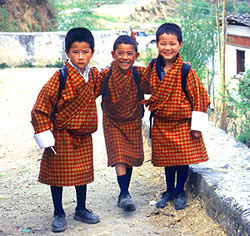Seated astride a flying tiger, Guru Rimpoche entered
Bhutan in the year 747 AD, to conquer demons and introduce Buddhism in
this isolated area of the Himalayas. In this far off kingdom, mythology
and history intermingle and ghosts, yetis, and demons are part of daily
life.
The name Bhutan is probably derived from the Sanskrit word Bhotant meaning “the
end of Tibet” or Bhu-uttan meaning “high land.” The
Bhutanese, however, refer to their country as Druk Yal, “Land of
the Thunder Dragon,” and the Bhutanese flag, with its rampaging
dragon, proudly reflects that.
Bhutan is nestled in the Himalayas between China and India. On its southwestern
border is the Indian state of Sikkim. To its north is Tibet. Almost the
entire country is mountainous. The southernmost part begins in the humid
jungles of India's Assam Plain, but soon climbs high into the Himalayas.
There is only one airport in the country and that is in Paro, a deep
valley at 7,300 feet elevation, surrounded by 16,000 foot mountains.
Only one airline flies into Paro, Druk Air, the Royal Bhutanese Airline.
The flight to Paro is one of the most spectacular in the world. Flying
over the Himalayas, the plane descends steeply between snow capped peaks
flying through the narrow valley to land at the tiny airport.
Bhutan's capital is Thimphu (pronounced “Tim - Pu”), a thriving
metropolis of around 40,000. The population of the entire country is
only 750,000.
The country is a monarchy, ruled by His Majesty King Jigme Singye Wangchuck,
46 years old. The king was married in 1988 to four sisters and he and
his queens have five princes and five princesses. It's good to be the
king!
Being a tiny country sandwiched between two of the largest countries
in the world, Bhutan makes it a top priority to maintain its traditional
culture. For all business, official, and religious occasions people dress
in the traditional costume, men wearing the gho, a long attractive robe
made out of wool or silk and tied about the waist, and women wearing
the kira, an ankle length dress made from fine woven fabrics with traditional
patterns. School children all wear their school uniform ghos and kiras.
The schools, incidentally, are required to teach their students in English
as well as the official language which is Dzongkha.
Houses and other buildings in Bhutan are built in the traditional style,
as dictated by religion and law. The houses are generally two stories,
constructed of wood and mud and elaborately decorated with carvings and
paintings of Buddhist symbols. The roofs are made with wood shingles
held in place by stones. On the top of every house is a colorful prayer
flag.
The major towns are dominated by the dzong, a huge white fort which serves
as a combination government headquarters and monastery. The system of
dzongs began in the twelfth century and the newest dzong was constructed
in 1998. There have been many fires in the dzongs over the years due
to the hundreds of burning yak butter lamps.
According to the Buddhist religion, when a person dies he is reincarnated.
When a great lama dies his reincarnation is identified and the child
is taken and educated so that he may continue the good work of his previous
incarnations. Lamas may marry, but only in every other lifetime.
On a recent trek in this beautiful country, I was accompanied by a Bhutanese
guide, a Tibetan cook, two village lady “wranglers,” and
four horses. As we headed up into the mountains, the clean air and pine
forests reminded me of California's Sierra Nevada. Unlike other Himalayan
countries, Bhutan's mountains have not been deforested. Soon, the sight
of shaggy yaks grazing in the high meadows, the colorful prayer flags
blowing in the wind at the top of each mountain pass, and the red-cloaked
monks wandering the dirt paths, reminded me that I had come a long way
from California—perhaps I had found the real “Shangri La.”
Click Here for information on our Bhutan Tours.



